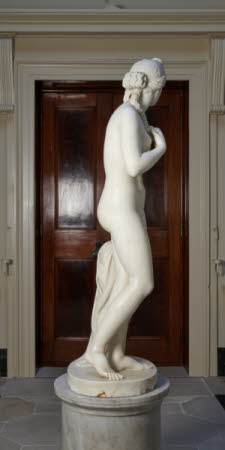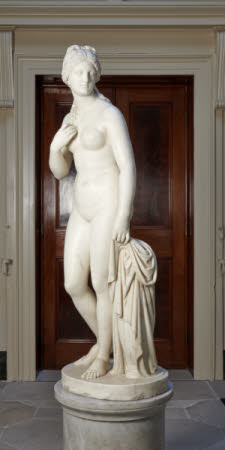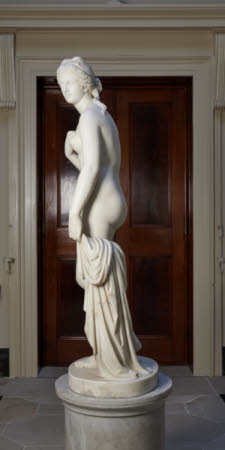Venus after the Bath
Lawrence MacDonald (Scotland 1799 - Rome 1878)
Category
Art / Sculpture
Date
1856
Materials
Carrara marble
Measurements
1595 x 572 mm; 470 mm (Diameter)
Place of origin
Rome
Order this imageCollection
Mount Stewart, County Down
NT 1221033.1
Summary
Sculpture, marble; Venus at the Bath; Laurence MacDonald (1799-1868); 1856. A full-size marble statue of a naked woman, standing by a fluted urn, probably a depiction of Venus, the goddess of love. One of two large sculptures of ideal subjects by MacDonald, acquired by the 4th Marquess of Londonderry for the Black and White Hall at Mount Stewart.
Full description
A full-sized standing figure of a young nude woman, representing the goddess of love, Venus (Aphrodite). She moves forward on her left foot, looking to her left and holding the end of one tress of her hair with her right hand, and with her left one end of a swag of drapery. The drapery falls over and partly covers a fluted urn. Venus’s wavy hair is parted at the front, drawn up into bows at the front and back, and held in place with a narrow band. Two tresses emerge from the bow at back, one falling over the right shoulder, the other down the back. On an integral oval socle, on the back of which is the sculptor’s signature and the date. Set upon a grey marble circular rotating pedestal. A pair to MacDonald’s Bacchante (NT 1221034). Laurence MacDonald was one of a generation of talented Scottish sculptors who led a small renaissance in the art of carving in Scotland in the early nineteenth century. He began his career working in Perth as a mason before moving to Edinburgh in 1822 where, however, he only remained for a few months, before leaving for Rome, where he arrived shortly after the death of Antonio Canova. MacDonald spent the next four years in Rome, living from portrait commissions, before returning in 1826 to Edinburgh, where he set up his studio. During the next few years MacDonald’s reputation grew, to the extent that he was even hailed by the Edinburgh Literary Journal in 1830 as ‘our Canova’. However, despite success in Edinburgh and in London, in 1832 he decided to return to Rome, where he settled for the remainder of his life and developed a flourishing practice, assisted by his brother John and, from the 1860s, his son Alexander (see NT 1139716). In 1844, in a sign of his growing status, MacDonald took over the lately deceased Danish sculptor Bertel Thorvaldsen’s former studio in the Piazza Barberini. By the 1850s, the decade when the two full-sized figures at Mount Stewart were made, a visit to Laurence MacDonald’s studio had become all but obligatory for cultured British tourists, many of whom commissioned their portraits from the sculptor. As one commentator wrote in 1852, ‘This artist’s studio is a real British Walhalla. It contains upwards of 300 busts of the British nobility and the most celebrated men of the day’ (Morning Chronicle, 19 February 1852). For Laurence MacDonald, as for many sculptors, portraits were an expedient way to earn a living, but he preferred to make ‘ideal’ statuary and seized all opportunities to do so. MacDonald’s figure of Venus is based on one of the most celebrated ancient sculptures in Rome, the Capitoline Venus, one of many derivations from the so-called Cnidian Aphrodite, a celebrated sculpture by the ancient Greek sculptor Praxiteles, long lost but known through copies (Haskell and Penny 1981, pp. 318-20, no. 84). The sculpture was found in the 1670s and presented to the Capitoline Museum in 1752, by Pope Benedict XIV. Although its reputation was at first eclipsed by that of the not dissimilar Medici Venus in Florence, the Capitoline Venus over time came to be more highly regarded by many than its cousin in Florence; by the nineteenth century it was certainly one of the highlights of the Capitoline museums. In his adaptation, MacDonald closely followed the Roman sculpture in the pose and slight forward movement of Venus, and the inclusion of the draped urn. The only substantive modifications are in the positions of the goddess’s hands, which in the Capitoline figure cover her breasts and pudenda in a gesture of modesty, whereas by moving them, Laurence MacDonald has created a more natural and informal, but also more voyeuristic composition. Unlike the Bacchante, the Venus was not among the catalogue of Laurence MacDonald’s works published by Count Hawks Le Grice in 1841, and it seems to have been slightly less sought-after as a model. A version, now at Grimsthorpe Castle, was made for the Hon. A.D. Willoughby (later 22nd Lord Willoughby de Eresby) in 1853 and was exhibited at the Royal Academy in 1854 (no. 1371) and also lent to the 1857 Manchester Art Treasures exhibition (Sculpture, no. 37). Another version made in 1857 is in a Scottish private collection. The version now at Mount Stewart was acquired in the late 1850s for the house by the 4th Marquess of Londonderry, presumably directly from the artist. The Londonderrys certainly visited MacDonald in the later 1850s, since formerly at Londonderry House was a portrait bust of Mary Cornelia, 4th Marchioness of Londonderry, made in Rome and signed and dated 1859 (Londonderry House 1939, p. 144). Jeremy Warren September 2022
Provenance
Acquired by Frederick Vane, 4th Marquess of Londonderry (1805 -1872); by descent; Lady Mairi Bury (1921-2009), by whom given to the National Trust in 1976
Marks and inscriptions
Back of base, near the urn: L. MACDONALD. FECIT / ROMÆ. 1856
Makers and roles
Lawrence MacDonald (Scotland 1799 - Rome 1878), sculptor
References
Mount Stewart 1950: Inventory and Valuation of the Contents of Mount Stewart, Newtownards, County Down, the property of the Marchioness Dowager of Londonderry, D.B.E. Prepared for the purpose of insurance by H. Clifford-Smith, M.A. F.S.A. 1950, p. 3. Roscoe 2009: I. Roscoe, E. Hardy and M. G. Sullivan, A Biographical Dictionary of Sculptors in Britain 1660-1851, New Haven and Yale 2009, pp. 777-78, nos. 32 and 35.









